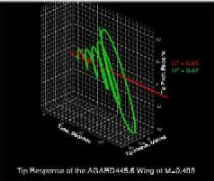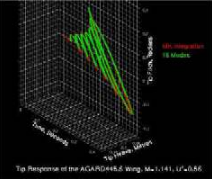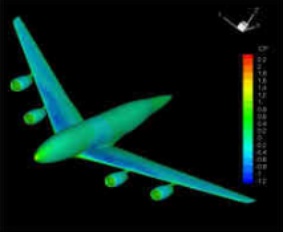Computational aero-servo-elastics
Staff:
Computational aero-servo-elastics
Accurate analysis of the interaction between aerodynamic and structural forces is of vital importance in modern aircraft design. Catastrophic failures such as flutter must be avoided at all costs, and although of less immediate concern, un-commanded control surface oscillations, such as LCO's and buzz, can in the long term do significant damage due to fatigue. Unfortunately, the majority of these phenomena involve significant contributions from non-linear behaviour, either in the aerodynamics, structure, or both. Accurate analysis is therefore complex, and requires time accurate simulation of moving and flexing bodies.
Work conducted on Computational Aeroelastics at the University of Bristol builds on over 12 years experience with unsteady CFD analysis methods, including the development of efficient time stepping methods, fluid-structure force and deflection data exchange, and grid deformation techniques. It has three principle aims:
- The demonstration of the practicality and effectiveness of coupled CFD-CSD (Computational Fluid Dynamics and Computational Structural Dynamics) for the analysis of complex aeroelastic behaviour, in order to allow a reduction in costly flight test programs.
- To develop insight into the nature and cause of these phenomena, including an understanding of how modelling parameters influence the realism of the simulation.
- Support the development of faster more flexible methods applicable in the design stage of a project, such as the Reduced Order Modelling work ongoing elsewhere within the group, by providing numeric test cases etc.
The group has developed efficient universal (mesh and flow-solver independent) methods for fluid-structure data exchange, and the required volume mesh deformation, based on multivariate function approximation, primarily adopting radial basis functions. This allows conservative exchange of CFD surface pressures to structural model forces, and structural deformation to the CFD surface and volume mesh. Further research is aimed at extending aeroelastic modelling to aeroservoelastic modelling and non-linear structural behaviour, through analysis and implementation of more flexible meshing options, flight control laws, and discrete control surfaces. The ultimate aim of this area of research is the time accurate simulation of a flexible aircraft undergoing free flight manoeuvre, the latter itself achieved through control algorithms incorporated in the primary model.
Many of the methods developed have been adopted within industrial simulation codes.




